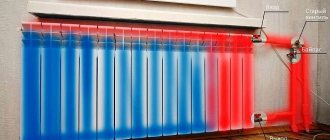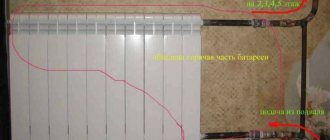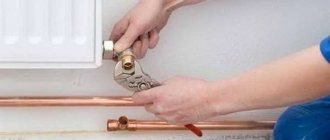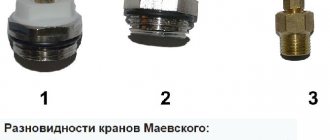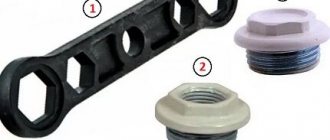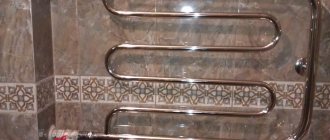Air in the heated towel rail is the main reason for the ineffective operation of the device. The towel drying device simply stops heating and therefore drying the towels.
The heated towel rail is an unusual pipe in the bathroom. First of all, it is an alternative replacement for radiators, which are often not installed in bathrooms. Secondly, a drying device paired with high-quality ventilation provides clean and dry air in the room, preventing the occurrence of fungus and mold.
As you know, the heated towel rail is warm even in the summer, when the heating is turned off, all because the device is connected to the hot water supply system. If the house is not connected to a centralized hot water supply, you can purchase an electric analogue.
Even a very beautiful heated towel rail may not heat well if there is air in it
Anyone who has used a heated towel rail for some time knows that you can’t live without it. The device is very useful in everyday life. Dry and warm towels are always waiting for you in the bathroom. You can dry small items (handkerchiefs, socks, etc.) or wet shoes on the heated towel rail.
The benefits of a heated towel rail in the home are well understood by parents who have to dry their children's gloves or boots every day in winter.
Faucet installation
When a production or self-installed air vent begins to leak, then the problem is dirty water. As a rule, dirt penetrates under the fixation screw. To eliminate it, you need to unscrew it from the equipment. If necessary, you can use a pin or other sharp object to clean the hole thoroughly.
Read also: How to draw a traffic accident diagram correctly
When airing often occurs, for example, due to regular water outages or poor quality of the water supply system, then you need to use the method with a Mayevsky tap. If you have to do this often, then it is recommended to install an auto-air vent.
Option for self-installation of a Mayevsky crane
Traditional method
If you follow the traditional method, you will need to expel the water from the heated towel rail . Since it is connected to the water supply system, you just need to drain the water through the riser. The situation becomes more complicated if there are many residential floors above you, since the descent is carried out on the top one.
If this does not help, slowly begin to unscrew the nut that secures the dryer to the pipe. Let us repeat that you need to unscrew it very slowly and as soon as you hear air escaping, you should not unscrew it further. It would be a good idea to place an empty container under the mounting location to prevent water from dripping from the pipe.
Modern method
This method involves installing a Mayevsky tap on a heated towel rail. Modern models are sold complete with it. Please note that the tap is not responsible for shutting off the water, but serves only as an air vent.
The Mayevsky tap includes a needle valve and an adjusting screw. In order to bleed off the accumulated air, use a flat screwdriver or a special key to turn the screw to open the valve.
The air must be released until hot water flows out of the small hole in a thin stream.
After this, the screw is tightened to the initial position and literally after a few minutes the heated towel rail begins to warm up and then become hot. What to do without a Mayevsky tap if you need to remove air? In this case, you will need the following tools:
- pliers;
- key;
- capacity (at least 10 liters);
- flat screwdriver.
Even without plumbing skills, you can loosen the retaining nut a little and bleed the air. If a gurgling noise appears, do not be alarmed ; this is how the system in which air has previously accumulated is filled with water. If you plan to carry out this operation in an old house, it is better to call an experienced plumber, since the nut may break.
This procedure will have to be carried out several times a year in order for the heated towel rail to function correctly.
Features of choice
When choosing a device model, you should consider some features of radiators:
- For centralized heating systems, the best solution is to use manual taps, which can be used to bleed air at any time. It is not advisable to use automatic taps in apartments or houses with centralized heating. The coolant in such systems is highly contaminated, as a result of which the tap hole will constantly become clogged with dirt;
- Automatically controlled faucets are good in private homes with autonomous systems, because the coolant is kept clean there. It is also recommended to install automation in places with difficult access;
Automatic air vent on battery - If the heating device is installed in some kind of recess or niche, then access to its end may be limited. In this case, it will be impossible to unscrew the screw with a regular screwdriver. Therefore, it is recommended to use an automatic Mayevsky tap for such a radiator. Or use a special key, which is located in the same plane as the battery;
- Many rooms still use old-style cast iron radiators. In this case, it is possible to install a manual Mayevsky valve for cast iron radiators, but it is better to use special automatic air vents made of brass, which have significant strength.
Mayevsky's manual tap on a heating radiator made of cast iron
Installing the Mayevsky crane
The design of the crane is very simple. The process of installing a Mayevsky tap on your heated towel rail will be just as simple. This should only be done in the summer, when the heating system is turned off . Its main purpose is to bleed air and start the normal operation of the device.
The main task is to choose the right diameter of the faucet so that it matches the diameter of the pipe in the bathroom. There are several design solutions - a tap that can be opened and closed by hand or a screwdriver.
When installing the Mayevsky tap, the outlet hole should be located downward so that the air drains faster.
You can deflate the heated towel rail with your own hands in a matter of minutes. To do this, it is enough to have the means at hand and the necessary tools, as well as follow simple tips.
Read also: Bell pepper lecho for the winter
Air in the heated towel rail is the main reason for the ineffective operation of the device. The towel drying device simply stops heating and therefore drying the towels.
The heated towel rail is an unusual pipe in the bathroom. First of all, it is an alternative replacement for radiators, which are often not installed in bathrooms. Secondly, a drying device paired with high-quality ventilation provides clean and dry air in the room, preventing the occurrence of fungus and mold.
As you know, the heated towel rail is warm even in the summer, when the heating is turned off, all because the device is connected to the hot water supply system. If the house is not connected to a centralized hot water supply, you can purchase an electric analogue.
Air vent cap
On the coil, the air vent can be hidden behind a decorative cap. But when you can’t find it on the coil, then most likely it is missing from the device. However, don’t give up: you can install it yourself. At the same time, the process itself does not require special skills, but it will eliminate problems with plugs in the coil in the future.
The air vent on the heated towel rail can be hidden under a decorative cap
Important!
The air vent must be installed at the peak point of the device, or leading to it. After all, air accumulates directly there.
To make an insertion into the supply pipe, you need to take a tee and a Mayevsky tap of the required diameter. As a rule, it is ¾ or ½ inch. The installation process is as follows:
- First you need to close the shut-off valves on the pipes to the device. If there are none, then you need to shut off the hot water riser. This must first be discussed with the property management company.
- Then you need to screw in the tee, as well as the air vent. It is important to use sealant or sealing tape.
- Then you need to supply water to the coil to check for leaks. At the same time, you should check how the air vent works. To do this you need to unscrew it in a certain way.
Replacing a heated towel rail
If troubleshooting does not help, the only way out of the situation is to replace the heated towel rail with a newer and more modern model. It should be borne in mind that in some cases this requires obtaining written permission from the management company. This is due to the fact that during such work, the water pressure in the house may weaken, which requires timely notification of neighbors and obtaining their consent.
Tools for replacing a heated towel rail
To replace a heated towel rail with your own hands, you will need the following tools:
- Welding machine.
- Connecting fittings.
- Pipe cutter or wire cutters.
- Bulgarian.
- Mounting brackets.
- Ball Valves.
- Polypropylene pipes.
Stages of work
Replacing a heated towel rail is carried out in several stages:
- Dismantling the old device. It is most convenient to cut the pipe using a grinder. After removal, the coil must be freed from its fastenings. Don’t forget to shut off the riser first and be sure to drain the water.
- Thread cutting. On water pipes you need to cut chamfers of the appropriate diameter. The reliability of fixation of the device directly depends on the quality of the threaded connection. In order to prevent the possibility of leakage, it is recommended to seal the joints using linen winding.
- Bypass installation. Its main task is to ensure the operability of the equipment in the event of malfunctions or emergency situations. This element of the system is a spare channel equipped with shut-off valves. After installing the bypass, it is necessary to install ball valves, with the help of which it will be possible to shut off the common house riser.
- Installing a new heater. Connect the device to the prepared threaded connections. It is important to consider that it must rest freely on the brackets, so it cannot be welded to fasteners. The optimal distance between the coil and the wall surface is 3-4 cm.
- Checking the connection quality. After completing the installation, you must ensure that the system is tight and check its functionality. Wait until the device warms up completely and make sure there are no coolant leaks. At the final stage, defects in the wall surface that may form during dismantling work are repaired.
Causes of breakdowns and troubleshooting methods for electric heated towel rails
Electric heated towel rails (often called design radiators) have a sufficient margin of reliability, but, like any other equipment, they can fail due to exhaustion, internal defects, overheating or power surges in the network.
Depending on the design, there are two types of electric design radiators - solid-filled and liquid. Heat transfer in the former is ensured by graphite and other compounds, while the latter operate by heating specially prepared water, antifreeze or a mixture of mineral oils. Solid-filled design radiators can use either a traditional spiral or tubular electric heater, or a heating film or cable. Liquid “towels” are built using traditional “dry” or conventional heating elements.
Design and installation diagram of an electric heated towel rail
In order to find the cause of the breakdown of an electric heated towel rail, you will need a multimeter, a set of screwdrivers and an adjustable wrench. The search begins with checking the integrity of the electrical circuit, gradually moving towards the power elements:
- check the presence of mains voltage in the outlet;
- “ring” the power cord with a multimeter - its resistance should not exceed 1-2 Ohms;
- when the substation is connected to the network, the voltage at the terminals of its heater is measured. If the multimeter shows the presence of 220 V, then this is indirect evidence of failure of the heating element;
- if there is no supply voltage at the heater terminals, check the serviceability of the contact group or the thermostat relay - the cause of the malfunction can be either burnt contacts or a poor electrical connection;
- if an electronic rather than a mechanical thermostat is used to control the temperature of the heated towel rail, then the reason for the lack of voltage on the heating element is more difficult to find. First of all, you should check the output relay or power semiconductors - powerful transistors, thyristors or triacs of the output stage. If they are in good working order, other components of the circuit are checked. If you do not have experience in repairing electronic devices, then it is better to entrust such work to a specialist.
All you need to diagnose and repair an electric heated towel rail is a multimeter, an adjustable wrench and a set of screwdrivers
Replacing the heating element in a heated towel rail is easy. If the type of device is unknown, then before disassembling it, the coil should be turned over so that the working fluid does not leak out. Then use an adjustable wrench to unscrew the nut on its flange, dismantle and replace the heater. Don't forget to check if there is any current leakage on the design radiator body. To do this, one multimeter probe is connected to the metal surface of the heated towel rail, and the other touches the heating element terminals in turn - the device should show an infinitely high resistance.
Burnout of the heating element is the main cause of failure of electric heated towel rails
Before assembling the heater, the level of the working fluid should be replenished (if there were leaks or some of the oil leaked out during operation), leaving room for thermal expansion. After this, check the integrity of the sealing gaskets and, if necessary, replace them with new ones. Next, with a force sufficient to ensure tightness, tighten the flange nut and check the performance of the heater in various modes.
How to bleed the air yourself?
As soon as the air is released, the heated towel rail will work again. There are several ways to get rid of excess air in the system.
In old houses, in apartments on the upper floors or even in the attic, there is a special valve for bleeding air from the heating or hot water supply system .
In the first case, you will have to contact directly the residents of the upper apartments, and in the second - to the responsible person who has access to the attic. Most often, he is a mechanic of the management company or a senior housekeeper.
Having reached the tap, you should open it and wait until water flows out of it. To avoid flooding the lower floors, you should prepare in advance by placing any large container under the tap.
After this, the heated towel rail should work. If this does not happen, then the previously performed manipulations should be repeated until a positive result is achieved.
Sometimes access to the tap is difficult for one reason or another, so you can resort to the second, more risky method of bleeding air - loosening the nut with which the heated towel rail is attached to the pipes.
When using it, you will need not only accuracy, but also some tools, namely:
- pliers;
- adjustable wrench;
- large basin (volume from 20 l).
Using pliers, you need to pull out a piece of metal wire, which usually fixes the position of the nut, and gradually loosen it with an adjustable wrench until the hissing of the air being released is heard. To avoid flooding, place a basin under the heated towel rail. Once again, it should be noted that this method is highly not recommended for use in old houses, since there is a high risk of breaking the thread on the nut and flooding everything around. You can resort to it only in the most extreme cases.
The third and easiest way to bleed air is to use special air vents, which are installed during the installation of a heating system in a private house or when replacing a heated towel rail in a city apartment.
Types of structures, materials
The heated towel rail, whose direct responsibility is to ensure that laundry dries quickly, also plays another role - it serves as a heater.
Principle of operation
All devices are classified according to the type of coolant.
- Mermen. This is a classic - coils through which hot water passes. More often they are connected to a water riser, less often (usually in private houses) - to a heating system.
- Electrical. These heated towel rails are heated by electricity. Advantages: no need to install them in a specific location (next to the pipes), the ability to adjust and turn them off to save energy.
- Combined - water and electric at the same time: two coils, one of which can be rotary, have different heat sources. They are distinguished from previous products by their increased price.
Self-installation is possible if a water model is purchased. In this case, outside help will not be needed. Electric or combined heated towel rails require skills. The simpler the design itself, the easier it is to handle its connection yourself.
Materials
The cost and reliability of heated towel rails depends on the materials used for their production. These include:
- Regular steel. This is the most budget option. Its disadvantages are relative: it is massive and not very attractive. However, the first disadvantage turns into an advantage, since these heavy structures are durable, the second is eliminated by painting.
- Stainless steel. This is an undoubted leader when it comes to price-quality ratio. These heated towel rails are durable, reliable, and look impressive without any decoration. They also don’t care about corrosion, temperature changes, or pressure.
- Brass. Copper. Such models often have complex shapes; they are resistant to corrosion, but are not able to withstand pressure changes as unshakably as steel. Copper is distinguished by its high speed of drying towels, but the high price is the other side of this coin.
Air in the heated towel rail: how to eliminate air pockets?
Air in the heated towel rail is the main reason for the ineffective operation of the device. The towel dryer simply stops heating, so dry the towels.
The towel dryer is the original pipe in the bathroom. First of all, this is another replacement for heat exchangers, which are often not installed in bathrooms. Secondly, a drying device paired with good ventilation provides clean and dry air in the room, preventing the formation of mold and mildew.
As you know, the towel dryer is warm even in the summer, when the heating is turned off, all due to the fact that the device is connected to a hot water supply structure. If the house is not connected to a centralized hot water supply, purchase an electric analogue.
Even a fairly beautiful towel dryer may not warm well if there is air in it
Anyone who has used a heated towel rail for some time knows that you can’t live without it. The device is extremely useful in everyday life. Dry and warm towels are always waiting for you in the bath. You can dry small items (handkerchiefs, socks, etc.) or wet shoes on the heated towel rail.
The advantages of a towel dryer in the house are well known to parents who have to dry their children's gloves or shoes every day in the winter.
Damage from an airy system
You can come to terms with the fact that towels take much longer to dry if the heated towel rail is not warmed up enough, but this device often also serves as a radiator in the bathroom, which is simply not installed.
Such conditions lead to a strong increase in humidity levels, which over time negatively affects the condition of the interior decoration. In addition, damp towels are a breeding ground for bacteria, mold and fungi, which can cause irreparable harm to human health.
Causes of air locks
This phenomenon can form at the top point of the heated towel rail in several situations.
Incorrect connection of the dryer. To achieve the greatest efficiency and performance, as well as to avoid problems for yourself and your neighbors, when installing a heated towel rail, you must comply with a number of certain standards. In particular, narrowing of the pipes should not be allowed; the slopes, as well as the connection diagram, must be fully observed.
Turning off hot water in the summer and then restarting it. The air that gets inside during this process can accumulate in the heated towel rail.
Incorrect shape of a particular device. This is usually found in products from manufacturers from China who do not go into too much engineering detail. As a result, models with thin pipes and sharp drops end up on the market, where a similar plug usually forms at the first opportunity.
There are known cases when hot water in pipes evaporates extremely slowly. The reason for this is the formation of bubbles inside, which prevent the liquid from moving normally.
Causes and symptoms of the problem
The air that appears in the heated towel rail can be determined by the main sign - the device simply stops working, while there is hot water in the house. It can be slightly warm or completely cold. First, let's look at the device's connection diagram to understand its differences from a conventional heating system:
The diagram clearly shows how the heated towel rail is connected
The first thing that catches your eye is that the heated towel rail is connected to the DHW circuit, and not to the heating circuit. In the vast majority of houses this is done this way due to the fact that the heating is turned off in the summer, and the heated towel rail must always be running. The goal is simple: maintaining a constant dry microclimate in the bathroom.
It is important! The task of a heated towel rail is not only to dry towels and other things hung on it, but also to maintain low humidity.
If it stops working, then mold and mildew may begin to form on the walls of the room, which in advanced cases can lead to damage to the finish of the bathroom, not to mention the possibility of diseases and simply reducing the comfort of using the bathroom. In addition, in steel heated towel rails (and the vast majority of them), a long-term absence of coolant leads to corrosion due to oxidation of the steel in air. Over time, this can lead to depressurization of the pipe and flooding of the apartment.
An ideal heated towel rail: large diameter pipes and a simple M-shape do not interfere with the movement of water in the riser
Now to the reasons for air locks in the dryer. There can be many of them, the most common are:
- Shutting off hot water supply in the summer and then restarting it. Air that enters the system during this process can accumulate in the heated towel rail.
- Incorrect dryer connection. To achieve maximum performance and not ruin the lives of your neighbors, you must follow a number of rules when installing a heated towel rail. In particular, avoid narrowing of pipes, observe slopes and connection diagrams.
- The shape of the heated towel rail itself is incorrect. This is the sin of Chinese manufacturers, without delving too deeply into engineering research. The result is dryers with thin pipes and sudden changes, in which an air lock forms at the first opportunity.
Such “designer models” should be avoided: water will not circulate in thin pipes, and narrow diameters for connection will create problems not only for you, but also for your neighbors in the riser
A discussion of connection diagrams is beyond the scope of this article; there are a great many of them. We'll just show the picture for your reference. If your heated towel rail is connected in one of the non-recommended ways, then the reason for its airing is most likely this:
Acceptable and non-recommended connection schemes
How to solve the problem of lack of heat in heated towel rail pipes
Heated towel rail installation diagram.
If the heated towel rail stops heating after a break in the hot water supply, then in order to correct this situation, it is necessary to bleed the air that has appeared in the water supply system. For this purpose, in multi-storey buildings on the top floor or in the attic, a special tap is installed on the top of the hot water riser, with the help of which the accumulated air should be released until water comes out of it.
After this procedure, the heated towel rail should start working normally. If the heated towel rail pipes are still cold, the operation will have to be repeated until a positive result is obtained. By the way, the same actions should be performed if the batteries do not fully warm up at the beginning of the heating season. Most often, air accumulated in them is also to blame.
This is what apartment owners do in long-built buildings who have not yet bothered to replace the heated towel rail installed many years ago with a more modern model. After replacing the heated towel rail and correctly connecting it to the hot water system, you will not have to run around the house looking for a place where you can bleed the air. All operations can be done without leaving the bathroom.
In order for the newly installed heated towel rail to be not only easy to use, but also to serve its owner for many years, it is necessary to choose it correctly, taking into account the basic requirements for its design when choosing.
About hot water supply
First, let's find out why airing of the water supply system occurs and how it interferes. Let's start from afar.
It always has a dead-end wiring: the bottling goes into risers, they branch into connections, and the connections end with taps of plumbing fixtures. Water moves in a dead-end circuit only due to water intake.
Dead-end DHW circuit
Until about the 70s of the last century, hot water supply systems (DHW) in all houses under construction were organized in the same way.
However, this wiring has two serious drawbacks:
- Having opened the hot water tap, the homeowner is forced to wait for several minutes for it to heat up. The wait is especially long at night and in the mornings, when in the absence of water supply the risers and hot water outlets cool down. This is not only inconvenient, but also contributes to unreasonably high water consumption;
Please note: when recording hot water consumption using a mechanical water meter, you are forced to pay for the entire volume passing through it. In fact, a significant part of this volume does not meet the requirements of current operational standards: the DHW temperature must be within the range of +50 - +75°C.
- Heating of bathrooms and combined bathrooms in apartment buildings is provided by a heated towel rail powered by a hot water supply system. It is clear that in the absence of water intake in the dead-end system it will cool down. For the apartment owner, this means dampness and cold in the bathroom, and in the long term, a greater likelihood of fungal damage to the walls.
Circulation scheme
Since the late 70s - early 80s, hot water supply in new buildings gradually began to become circulating.
How it's implemented:
- Two hot water supply outlets are laid in the basement or subfloor of the house;
- Each bottling has an independent insertion into the elevator unit;
- The hot water supply risers are connected alternately to both dispensers and are connected by jumpers on the top floor or in the attic. From 2 to 7 risers can be combined into groups connected by circulation jumpers.
Please note: installing lintels in the attic is extremely unwise in cold climates. The author encountered it in the Far East: at a temperature in a cold attic of -20 - -30 degrees, stopping circulation in the hot water system (for example, during an emergency shutdown of hot water) causes the water in the jumper to freeze within an hour.
In order for water to continuously circulate through risers and bottlings, a pressure difference must be created between them. In the elevator unit and further, in the heating circuit powered from it, circulation is ensured by the pressure difference between the supply and return pipelines of the heating main. The obvious way to supply hot water is between the supply and return connections.
However, in this case, an unpleasant surprise awaits us: the bypass between the pipeline threads will catastrophically reduce the drop in the water jet elevator, preventing the heating from operating.
The problem can be solved simply and elegantly:
- The hot water supply cuts into the supply to the elevator at two points. Each of the inserts is equipped with shut-off valves;
- The flange between the inserts is equipped with a retaining washer. This is the name of a steel pancake in which a hole is drilled in the center with a diameter 1 mm larger than the diameter of the nozzle. During normal operation of the elevator and the associated movement of water along the supply line, such a washer creates a difference between the tie-ins of approximately 1 meter of water column (0.1 atmosphere);
- Exactly the same two tie-ins with the same retaining washer are mounted on the return pipeline.
An elevator with hot water circulation taps has three operating modes:
- Hot water circulates from supply to supply
. This scheme is used in spring and autumn, at a relatively low (up to 80 degrees) coolant temperature in a straight line of the heating main; - From return to return.
DHW switches to this mode in winter, when the supply temperature exceeds 80°C; - From supply to return.
So the hot water supply system with circulation is powered in the summer, when the heating is turned off, and the difference between the threads of the heating main is minimal or absent.
When air removal is not possible
It is guaranteed that it will not be possible to remove the plug if the heated towel rail is tied incorrectly. For example, in the indicated diagram the substation is located too close to the riser.
When tying, a “dead loop” is made higher than the point where it is connected to the riser. This area will constantly air the system, and releasing the air plug from it is impossible, especially with a secretive method of pipe routing.
With a lower supply of coolant in the riser, narrowing the bypass leads to loss of circulation. In turn, air begins to be intensively released in stagnant water. One problem piles on top of another. If the user does not know the direction of water supply, it is better to connect the heated towel rail through a bypass of standard diameter.
Thus, the easiest way is to bleed the air lock from the heated towel rail through the Mayevsky tap. In rare cases, when the device is not equipped with an air vent, it is enough to simply loosen the union nut on its outlet pipe, taking into account the circulation pattern.
If you are a master, follow this link, register in the system and be able to accept orders.
Why do you need to bleed your heated towel rail?
The heated towel rail is designed for drying wet laundry. Thanks to this device, the indoor microclimate is maintained. Drying helps soften the environment. As a result, the appearance of a large number of harmful microorganisms on the walls, baseboards and ceilings is prevented:
After using the product for a long time, water circulation may be disrupted. Air mass begins to accumulate inside the unit. A traffic jam occurs that affects the functionality of the device. It stops heating, and its properties and positive qualities are lost. To get rid of the plug, you need to drain the water. The main reasons for performing such an operation are:
- Evaporation of hot water in pipes occurs very slowly. This phenomenon is associated with the formation of air bubbles inside the pipe, preventing the free movement of the heated liquid.
- Another reason may be to restart the water supply if for some reason there is a break in operation.
- The cork appears due to an incorrectly selected product shape.
- Incorrect connection.
In order not to deteriorate the quality of the atmosphere, the air lock must be eliminated.
How often should you bleed the heated towel rail?
Many users are facing this problem. Let's say right away that as soon as there is a problem with the heat supply, the operation must be performed immediately. There is no need to put off bleeding air from the heated towel rail until later, as this process begins to worsen significantly over time. If everything is done on time, after the mass is released, the device design will begin to work at full capacity.
Application of the Mayevsky crane
Unscrewing the nuts and lowering the riser should be used only in certain cases, if there are no other options. The method is not the most practical and safe. Models of modern coils have a special air vent, which is called a Mayevsky tap. This is a standard needle valve.
This valve is opened by turning a screw. The small diameter of the holes will not allow you to flood the room with hot water, but only drain the required volume until all the air escapes. There is nothing stopping you from using the most standard water taps to bleed air. But because of them, the residents of the house abused the drainage of water for their own needs. Therefore, in the 30s of the last century, Mayevsky invented such a crane.
Using the Mayevsky crane
The use of Mayevsky’s air vent cannot cause any difficulties for anyone:
- First you need to prepare a container for draining up to 15 liters; you need to place it under the tap itself. It is worth noting that the white plastic area can be rotated in different directions. This allows you to direct a small hole to the desired location.
- After loosening the fixing screw using a screwdriver or the desired nut. As a rule, half a turn is enough to open the valve, and then begin to bleed air. You cannot unscrew the screw too much - then the water pressure will not allow you to screw it into place.
- It is important to wait for the hissing to complete. Clean, air-free water should begin to flow.
- After this, the screw should be put in place.
This completes the process of releasing air. It is much simpler and at the same time extremely safer than unscrewing the nuts or the process of restarting the riser.
Automatic air vent
The design of the auto air vent is as simple as a manual device.
The float, which is connected to the spring-loaded valve, is not able to allow the valve to open if there is no air. If there is air in the device, then the float goes down. This opens the valve and allows air to escape. The valve closes automatically under the influence of water. In this case, the device must be installed at the peak point - otherwise there will be no reliability in good operation.
The article presents all the reasons for the formation and method of eliminating air plugs in the coil. It is important to use the Mayevsky tap and there will be no problems in the heated towel rail.
Automatic air vent design
If problems occur frequently, you need to check whether the heated towel rail is connected correctly. There is often a situation in which bad plumbers interfere with the operation of common house systems. Because of this, even calling a technician will not guarantee correct installation. At the same time, certain types of devices, due to their shape, can inhibit the flow of water, as a result of which they do not warm up well. In situations like these, it is important to consider changing your device. A correctly selected and installed coil will require virtually no manipulation of the air bleed.
Solving problems related to the heating system
In every home, be it a separate or rented apartment, a private house or some other premises, there is a heating system that ensures heating of the structure during the cold seasons.
In order for it to function reliably and productively, you must first choose exactly the method of its implementation that is suitable for the specific conditions created in your home. Heating can be gas (to which we have all become accustomed for so long), stove and electric. You will have to tinker with each of them both at the installation stage and at the stages of further operation.
Heated towel rail connection diagram.
For example, with gas heating, such problems include malfunctions in the functioning of the gas boiler, its clogging or reset of program settings. Only a professional gas service worker can cope with this situation on their own. But sometimes this knowledge is not enough, since a problem may also arise with the functioning of the microcircuits; to solve it, you will need the help of an electrician.
As for stove heating, everything is more or less clear, since stoves have been used in our country for quite a long time and practically nothing has changed in their design. Therefore, in order to clean the pipe or plaster some chips or holes in its body, you will not need to seek qualified help from a stove maker.
But you shouldn’t immediately turn your attention to a brick or metal stove. After all, those gas boiler breakdowns that were described earlier are quite rare, and then only due to poor quality or too long use. This requires serious effort. Much more often you will have to deal with not very significant interruptions in the operation of this equipment, which you will be able to fix with your own hands.
Return to contents
Which heated towel rails don't have traffic jams?
According to the current SP and SNiP standards, the heated towel rail must crash into the riser in parallel. In this case, its part between the lower and upper insertion automatically becomes a bypass.
In complex structures with long pipe lengths or their complex geometry (for example, a ladder with shelves), the hydraulic resistance increases sharply. Water does not enter them, preferring the path of least resistance - bypass.
Therefore, this element is narrowed - a piece of the riser is cut out, the PS is connected to it with bends, and the bypass is made from a piece of pipe, the diameter of which is one size smaller than that of the riser.
During Soviet times, a U-shaped heated towel rail in the bathroom was installed directly, without a bypass. It is this option that guarantees the absence of air jams in any direction of flow in the riser.
The problem of airing the PS of the upper floor in houses without hot water supply with hot water pumps during the autumn heat switching on was solved by installing a valve in the attic with a brush under the hose, allowing air to be released along with cold water to start the circulation of the system.
Step-by-step instructions for installing KM into the system
At the first stage, preparatory work is carried out. It is advisable to carry out the installation in the warm season, when it is possible to remove coolant from the heating system. Often in old radiators there is no special hole for the CM, so it must be drilled.
- At the first stage, the pipes are removed.
- Remove the radiator from the hooks and completely drain the water.
- On the side opposite from the pipe entrance, a hole is drilled in the top plug, the diameter of which corresponds to the purchased CM.
- The threads are cut inside according to the one used on the KM. It should be taken into account that the tap has a right-hand thread, therefore, the plug has a left-hand thread. Another option is to replace the entire plug at once.
- Then install the tap, as indicated in the instructions for the device.
- The battery is returned to its place.
- At the last stage, the pipeline is connected.
For cast iron batteries, factories produce ready-made plugs for air vent valves
The tap outlet is directed slightly downward. This makes it easier to collect the water that should flow from the tap.
When installing the device on heating pipes made of plastic, a fitting will be required.
Attention! Valves with manual control are usually installed horizontally, automatic valves are installed vertically. The correct installation must be clarified in the instructions.
Video - Equipping a heated towel rail with an air vent tap
Typical problem
After some time of active use of the device, you may be unpleasantly surprised to find that it has stopped heating, and sometimes is completely cold. Air accumulated inside the heated towel rail interferes with proper water circulation , so the drying device does not heat up. There is only one correct decision left - to lower him.
If it is cold for a long time, it can negatively affect the air quality in the bathroom, and mold will begin to appear on the walls and ceiling.
Why does an air lock occur in the heating system? If we consider central heating, this is due to air entering the system at the time of its startup . Another typical problem is the slow evaporation of hot water in the pipes. The place of the former water is filled with bubbles, which make it difficult to supply hot water.
Next, we’ll look at how to bleed a heated towel rail and eliminate air build-up.
Varieties
There are three types of air vents, differing in operating principle and design:
1. Mayevsky manual tap . This is the simplest device that is controlled manually. If uneven heating of the radiator is detected, the tap can be opened with a key or any screwdriver, and then, as air leaves the radiator, turn the tap in the opposite direction.
The photo shows a Mayevsky manual type crane
2. Automatic tap . The difference between an automatic crane is the absence of manual control of its operation. Its design and operating principle are somewhat different from the functioning of a manual crane. An automatic faucet is made of brass in the form of a cylinder, but there is no needle valve in its design. Instead, a plastic float is used. How does an automatically controlled Mayevsky crane work? A plastic float, depending on the presence of air in the system, moves inside the tap and controls the opening and closing of the valve. Everything happens without human intervention.
The principle of operation of the Mayevsky automatic crane is visually demonstrated in the photo above.
All automatic taps have the ability to be manually controlled, which can be used when the passage opening becomes clogged.
3. Crane with built-in safety device . For this type of Mayevsky crane, the principle of its operation is somewhat different from the usual bleeding of air. The safety valve is able to control the coolant pressure in the system. If the coolant pressure exceeds the limit value, reaching 15 atmospheres, the valve will operate and begin to forcibly bleed the coolant from the heating system. This prevents damage to individual elements of the system in the event of sudden water hammer.
It is especially important to install air vents with safety valves in heating systems made of polypropylene and metal-plastic pipes, which may not withstand high pressure.
How to deflate yourself
The procedure for bleeding a bathroom dryer depends on the water supply. If you live in a private house with your own water supply system, you should be aware of its circuit and where you can open the tap to get rid of the air lock.
It is important! In apartment buildings, everything is more complicated. You may have to bleed the entire riser if this is the problem. But first, try starting with a heated towel rail in your apartment. What is described below applies only to old heated towel rails without an air vent (Maevsky tap).
Using an adjustable wrench, unscrew the nut that connects the dryer to the hot water pipe.
The nut should be unscrewed very slowly and carefully, because there is a risk of stripping the thread, especially on old Soviet-era heated towel rails
Also prepare a container in advance and place it under the heated towel rail. Having loosened the nut a little, you should wait until the hissing stops and water flows out without air. Then the nut can be screwed back on.
If this method does not help, then you need to bleed the air from the entire riser. And here it all depends on the building where you live, because the riser designs in all houses are different:
- Old five-story Soviet-built buildings: here the hot water riser reaches the 5th floor and makes a loop down to recirculate hot water. Since air accumulates at the highest point of the system, you will have to go to your neighbor from the top floor and bleed the air from the pipes there. Often a hose is already prepared there, which needs to be put on a special tap at the top of the riser, lowered into the sewer and, opening the tap, drain the water until the air disappears.
- Nine-story panel buildings: here you can only bleed air from the attic, since all communications end there. Check if you have access to the attic space. Usually only plumbers from DEZ can go there, then you need to call them. If the attic is open, you can drain the water yourself; the technique is similar: find the hot water pipe and the outlet from it, open the tap and drain the water into the sewer.
- Other houses: in this case, your only option is to call the maintenance service, since the technical floors are usually closed. The procedure is called “restarting the riser”, during which the entire hot water riser is drained in the basement and then filled with water again.
Where to install the device?
The device is installed at the highest points of the premises network. However, in addition, the installation diagram of the heating network is taken into account.
The vertical method of supplying coolant requires that each radiator located on the top floor, where there is a lower supply with a return line, be equipped with a KM.
Air valves are also needed everywhere on devices in which the supply line is completely or partially below the level of the upper connection axis. Then the natural elimination of the oxygen plug becomes more difficult. In the horizontal version of the circuit, the CM is placed on each heating radiator.
Placement of Mayevsky air vent valves for both scheme options
Air valves are also installed in areas where there are bends in the pipeline. So, for example, when a pipe bends sharply upward and then descends down a short section, a pocket is formed. Airing will constantly occur in this area. The crane is installed here at the top point of the site.
The “warm floor” system in most cases also requires the installation of this equipment. Air release is most effective on the collector group, which rises above the floor level.
“Heated floor” systems are rapidly gaining popularity among owners of private country houses and city apartments. In a special article we will tell you whether it is possible to connect a “warm floor” from heating.
Mayevsky taps are also installed in the towel dryer in the bathroom. This is necessary when airing occurs regularly in the system. The manufacturer provides a hole for the valve in heated towel rails connected from below. When connecting laterally, this section of the pipe is slightly modified. Then a tee with the required thread parameters is implanted into the supply zone. Install the device, directing the outlet away from the wall.
It is important! If air constantly accumulates in the pipes, then during the next repair it is worth purchasing models of towels that are already equipped with a Mayevsky tap.
Installing a jumper to allow operation without shutting off the hot water supply
During operation of the heated towel rail, it may be necessary to replace the seals connecting the device to the water supply system. The service life of even the highest quality seals usually does not exceed 3 years. So that when replacing seals or the heated towel rail itself there is no need to shut off the water in the riser, thereby depriving neighbors of the opportunity to use hot water, care should be taken to install a jumper.
This work should be entrusted to a specialist who knows the necessary techniques for connecting pipes. To do this, in the places where the heated towel rail is connected to the riser, you should install ball valves and install a jumper, which also has a valve. With the taps at the inlet and outlet of the device closed and the tap at the jumper open, you can safely work without disturbing the water supply of your neighbors.
The best posts
- Gorodets painting for beginners on wood: templates with photos
- Ladder on bowstrings: features of installation of the structure (fastening and installation of the bowstring)
- Small yellow ants in the apartment: how to get rid of them
- How to functionally use a window sill in a small kitchen?
- Features of use and technical characteristics of hardboard
- DIY origami paper box with lid and surprise
- [Savings] Drywall fireplace: luxury accessible to everyone
- Marble tiles for the bathroom - tips for choosing
What you need to know when choosing a heated towel rail
Shapes of heated towel rails: a - m-shaped; b - U-shaped; c - f-shaped; g - “snake”; d - “ladder”.
Manufacturers of sanitary equipment use mainly two materials in the manufacture of heated towel rails - stainless steel and brass coated with a layer of chrome. At first glance they look exactly the same. All of their differences lie in their different ability to withstand operating pressure differences inherent in the supply of heat and hot water to multi-storey buildings.
Steel products are more durable than those made of chrome-plated brass, therefore, in multi-storey buildings, steel is mainly used, since in heat supply and hot water supply systems pressure drops sometimes reach 8-10 atm.
When choosing a steel heated towel rail, you should choose products made from seamless pipe, the thickness of which must be at least 3 mm. The absence of a welded seam on the pipe guarantees that there will be no leaks that are possible during the operation of a product made from a welded pipe.
Domestic manufacturers practically do not produce brass heated towel rails. The plumbing products market offers imported products, which are mainly used in low-rise, private construction when equipping houses with an autonomous heating system.
Of course, imported brass plumbing has a more varied shape and is more attractive in appearance, but it is designed for much less pressure than sometimes occurs in the pipelines of multi-story buildings. Therefore, they are purchased for installation in cottages, country houses and country houses, where an autonomous system with an operating pressure of about 3 atm is installed.
When choosing a heated towel rail, you must take into account an important feature of its design - the product you like must have a valve through which you can bleed air if necessary. Such a valve is manufactured by domestic manufacturers under the name “Mayevsky tap”. With its help, the problem of first starting up a heated towel rail after its installation or after connecting the system to the water supply after a maintenance break is easily solved.
Design of the “Maevsky crane” and its correct installation
Installation of a heated towel rail to the wall (diagram).
Many people who are not very knowledgeable in technology, hearing the name “Maevsky faucet”, imagine that this is a very complex piece of plumbing equipment, and some do not even know what it is needed for. In fact, there is nothing complicated in its design; the simplest “Maevsky tap” includes only two parts - a body and a conical screw.
At its core, this design is a reliable air outlet. The principle of its operation is as follows: when the tap is open, air from the heating system enters its body through the inlet, and at the same time is removed through the outlet located in its side. When closed, the screw fits tightly to the inside of the housing, preventing liquid from escaping from the pipeline.
